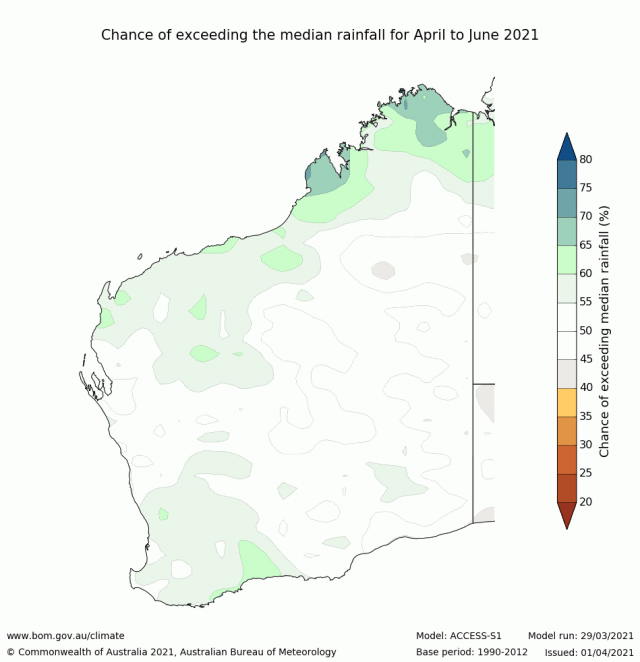Summary
The Department of Primary Industries and Regional Development’s (DPIRD) Statistical Seasonal Forecast (SSF) outlook for April to June 2021 is indicating less than 40% chance of exceeding median rainfall for the majority of the South West Land Division (SWLD). SSF longer outlook for April to October is indicating similar chances.
- For April to June 2021, the SSF is indicating less than 40% chance of exceeding median rainfall for the majority of the South West Land Division (SWLD). The most probable rainfall decile map indicates decile 2-3 for the SWLD. Predictive skill based on March conditions is mostly poor to good (50-100% consistent).
- The longer lead SSF forecast of April to October is also indicating less than 40% chance of exceeding the median rainfall for the majority of the SWLD.
- The Bureau of Meteorology’s seasonal outlook for April to June indicated 55-65% chance of exceeding median rainfall for the SWLD. Predictive skill is poor to moderate (50-65% consistent). The longer term outlook for May to July is mostly neutral to below median chance for the majority of the SWLD with poor to moderate predictive skill (50-65%).
- Temperature outlooks from the Bureau for April to June 2021 indicate a 60-80% chance of above average day-time maxima and above average night-time minima for most of the SWLD (skill for maximum temperature is 55-75% and for minimum temperature is 45-65%).
- March rainfall was above average for the SWLD due to a broad trough and a weak low pressure system producing thunderstorms and showers in early March. March maximum temperatures were average to above average and minimum temperatures were above average.
- The La Nińa in the Pacific has now returned to neutral. The Madden–Julian Oscillation (MJO) is currently the strongest climate driver influencing Australia. The MJO has moved into the Australian region at moderate strength and is expected to bring increased cloudiness and rainfall to far northern Australia and the broader Maritime Continent over the next week or two. This also brings an increased risk of tropical low/cyclone activity. For the SWLD, the warmer Sea Surface Temperatures in the Indian Ocean currently influence the climate.
Three month outlook for the SWLD of Western Australia
Statistical Seasonal Forecasting (SSF)
DPIRD’s Statistical Seasonal Forecast (SSF) system uses historical relationships between global sea surface temperature and sea level pressure with rainfall in SWLD Australia to produce forecasts of rainfall for the coming months. Users can click on any station indicated on the map for location-specific forecast information from the Seasonal Climate Information [1] web page.
For April to June 2021, the SSF is indicating less than 40% chance of exceeding median rainfall for the majority of the South West Land Division (SWLD). The most probable rainfall decile map indicates decile 2-3 for the SWLD. Predictive skill based on March conditions is mostly poor to good (50-100% consistent).
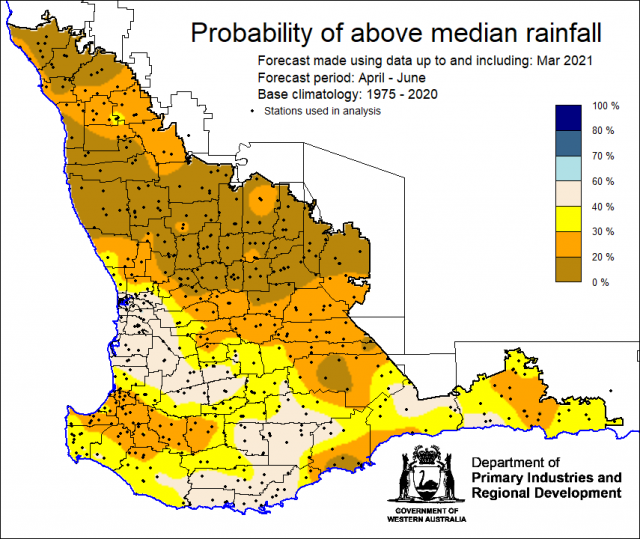 [2]
[2]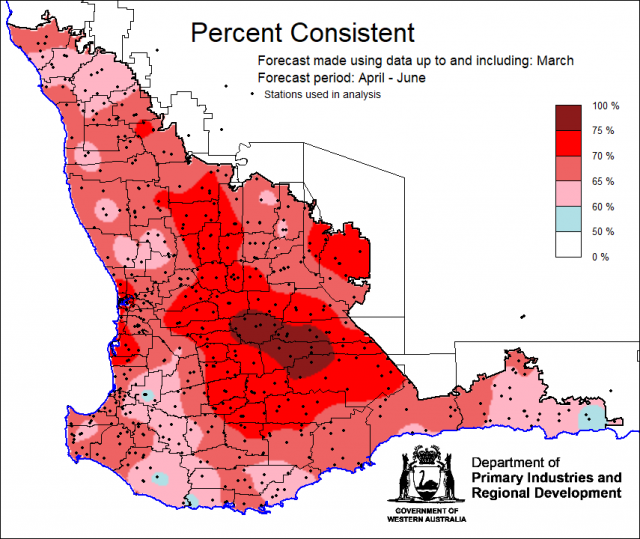 [3]
[3]
Bureau of Meteorology seasonal climate outlook
The Bureau of Meteorology's climate forecast system for monthly and seasonal climate outlooks is the Australian Community Climate Earth-System Simulator – Seasonal (ACCESS-S [4]). It is a dynamical (physics-based) forecast modelling system and is a collaboration between the Bureau of Meteorology and the UK Meteorological Office.
The Bureau of Meteorology’s seasonal outlook for April to June indicated 55-65% chance of exceeding median rainfall for the SWLD. Predictive skill is poor to moderate (50-65% consistent). The longer term outlook for May to July is mostly neutral to below median chance for the majority of the SWLD with poor to moderate predictive skill (50-65%).
Temperature outlooks from the Bureau for April to June 2021 indicate a 60-80% chance of above average day-time maxima and above average night-time minima for most of the SWLD (skill for maximum temperature is 55-75% and for minimum temperature is 45-65%).
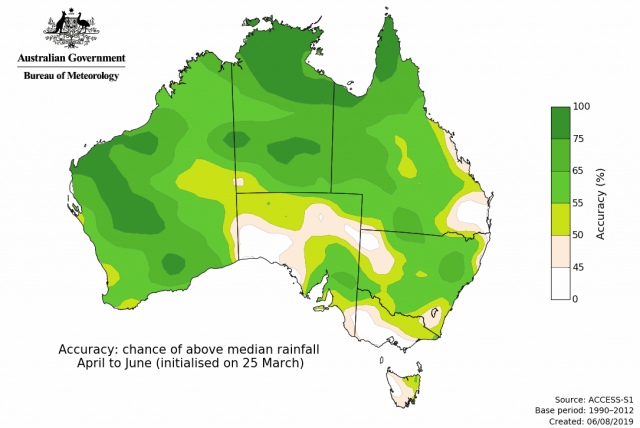 [6]
[6]The majority of other rainfall forecasting models are suggesting neutral chances of exceeding median rainfall for April to June 2021.
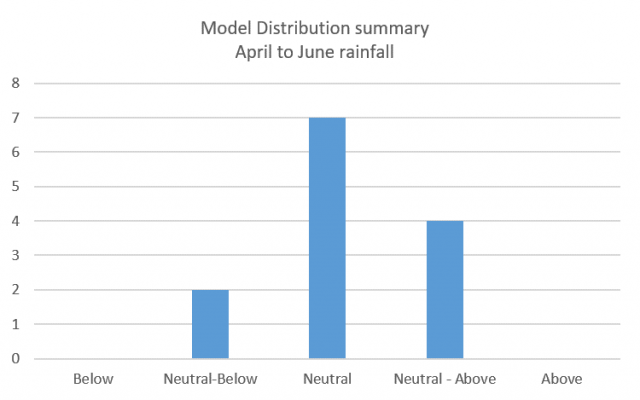 [7]
[7]SSF forecast for April to October
The SSF forecast for the South West Land Division for April to October 2021 is indicating less than 40% chance of exceeding the median rainfall. For the Lower West forecast district, chances are for neutral to higher. The most likely decile range map is indicating decile 2-3 rainfall. Skill is moderate to good at 60-75% consistent.
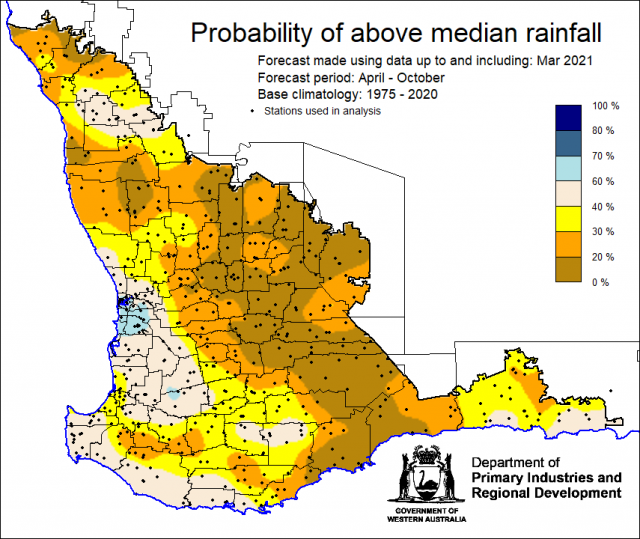 [8]
[8]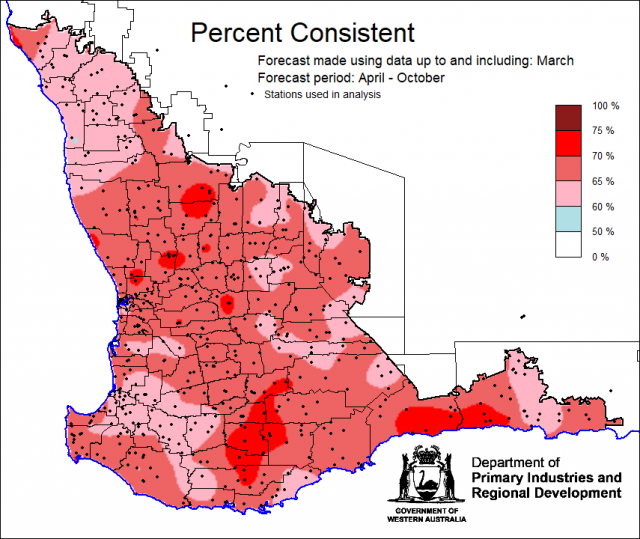 [9]
[9]Recent climate
March rainfall was above average for the South West Land Division (SWLD) due to a broad trough and a weak low pressure system producing thunderstorms and showers in early March. Toodyay recorded 151 mm of rain in March. Maximum temperatures in March were average to above average and minimum temperatures were above average. Decile rainfall to date map from 1 January to 6 April indicates decile 8-10 rainfall for most of the SWLD.
In March the atmospheric pressure [11] was lower than normal over the SWLD.
Sea surface temperatures [12] (SST) are warmer than average around much of the north, west and southeast of Australia. Warm SST anomalies to the west and northwest of Western Australia may be influencing local weather patterns.
The Southern Annular Mode (SAM), also known as the Antarctic Oscillation (AAO), describes the north–south movement of the westerly wind belt that circles Antarctica, dominating the middle to higher latitudes of the southern hemisphere. SAM is currently neutral and excepted to remain neutral throughout April. A neutral SAM has little influence on Australian rainfall. During autumn, SAM has less influence on rainfall than during other times of the year. For more information see the Bureau of Meteorology’s Climate Driver Update [13].
The Indian Ocean Dipole (IOD) is neutral. Majority of models are indicating a negative IOD in July, but skill is low at this time of the year.
The La Nińa in the Pacific Ocean is now officially finished with most El Niño–Southern Oscillation (ENSO) indicators have now returned to neutral levels. Climate model outlooks suggest the Pacific will remain at neutral ENSO levels at least until the winter.
The table below summarises climate conditions over the past month and three-month periods, and can indicate what is likely to occur in the near future if climate conditions follow the current pattern.
| Climate Indicator | Past month | Past 3 months |
|---|---|---|
| SWLD Rainfall [14] | Very much above Average | Very much above Average |
| SWLD Mean Temperature [15] | Above average | Above average to average |
| SWLD atmospheric pressure [11] | Lower | Lower |
| Indian Ocean Sea surface temperature [16] | Warmer | Warmer |
| El Niño/Southern Oscillation [13] (ENSO) | Neutral | La Niña |
| Indian Ocean Dipole [17] (IOD) | Neutral | Neutral |
| Southern Annular Mode [18] (SAM) | Neutral | Positive |

